WHAT SHOULD I GROW IN MY NEW GARDEN?
Well that is going to depend on you and what you like. I will offer a few suggestions of plants that are worth growing and what is best avoided. These are not all going to be plants that we sell, while all of us here consider that including some medicinal herbs into your garden is pretty essential for many reasons for the most part what you are most likely going to want to grow is food. Some plants are easier to grow than others and give better rewards.
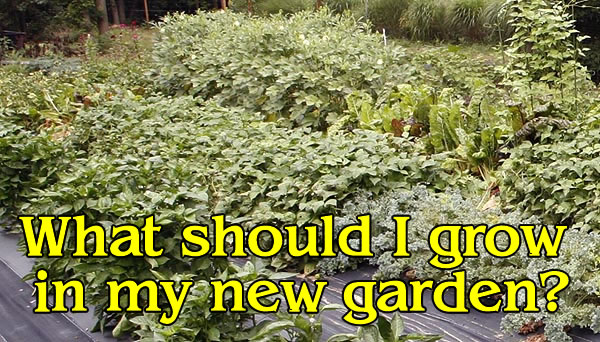
IMPORTANT NOTES
1. Rotation of crops.
It is vital that you NEVER plant the same kind of plant in the same spot
for the next year or if using smaller crops the same spot over and over
again.
There are several reasons for this.
- Disease. Quite a few crops are susceptible to disease. Most
tend to overwinter in the soil so if you plant the same kind of crop
in the same spot next year you will get problems with it.
- Soil nutrients. Different plants take different things from the soil and put others back in. The first year you will most likely get great plants, provided your soil is good, but if you plant the same thing in that spot the next year most likely it will do much more poorly because the previous crop sucked out all the nutrients that plant needs. Putting a completely different crop in there will give much better results. Try to rotate on a four year basis. That is don't plant the same thing in the same spot for four years. This is quite hard to do in a small garden but do your best.
2. Time of the year.
For the most part plants will go in after the danger of frost has past,
but there are quite a few that need to be planted very early because they
are cool season crops. If you live in zones 5 and above its still time
to plant cool season crops but if you live in warmer areas its too late
for some things. These include:
- Peas
- Fava or broad beans
- Potatoes.
- Garlic. (garlic is planted in the fall for best results, very early
spring is possible but not as good.).
- Cilantro. Cool season crop, plant in fall if you still want it.
EASY VEGETABLES.
1. Salad greens. These grow very fast and are extremely easy to grow. For the most part they will only give you one crop then you will need to reseed them. Some may grow back it will depend on the variety.
2. Bush or pole beans. If you have not grown beans before then bush beans are most likely the best option for you. Pole beans need a support frame to grow up and that takes more time to create. However you can get some great beans this way and they take less ground space, but you do need to consider the shade cast on other plants. We recommend our Yin Yang beans as they are really great tasting and can be used as both green beans and/or left to create dried beans for winter use.

Yin Yang bush beans. Tightly compacted they first flower all at once
for main crop then progressively for the rest of the season.
3. Okra. Yes I know its not the most common vegetable but okra is a wonderful nutritious vegetable. Its extremely prolific starting to fruit when its just two feet tall and continuing until the frost cuts it down. The young pods are delicious, but you can also eat the leaves and the flowers so it provides so many different options. Its just a matter of finding the best recipe to cook them. We prefer stir fry they are wonderful. Okra is also very medicinal and can be used in many digestive issues so it's a vegetable and a medicine. It's worth growing.
4. Peppers. All kinds. These are easy to grow but they will need staking or cages to keep them upright depending on the variety. They are not hard to grow and produce until frost kills them. We like to grow Red Sweet Peppers and some hot peppers. Some hot peppers should be stored and made into tincture, they are a great first response is someone has a heart attack.
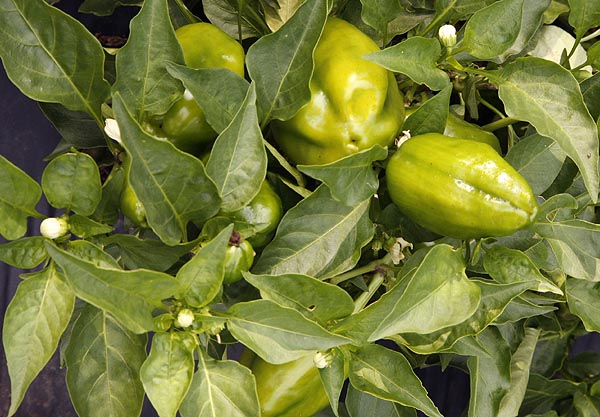
Sweet peppers can be very prolific. The sooner you can plant after
frost the better. These peppers will continue to flower and fruit right
until the frost kills them.
5. Eggplant. Also easy to grow as peppers.
6. Leeks, carrots, parsnips and other root vegetables.
Very easy to grow and care for, don't have that many problems unless the
voles eat the roots out.
7. Tomatoes. Easy to grow but do have more problems that the other crops listed here. Susceptible to many more diseases and pests so you need to take care of them, prune them for airflow and watch for pests like caterpillars.
8. Cucumbers or zucchini. If you have a trellis. Making a trellis is fairly easy but these plants will roam if left on the ground. If you have a trellis to get them up on and keep them contained its an easy plant to grow.
9. Purslane. Not the most usual vegetable but an extremely nutritious green that is very easy to grow and very prolific. Takes little space but gives a lot in return.
PLANTS FOR LARGER PLOTS.
Anything in the squash family. These plants get big and will spread out in all directions. If you have land that you are not using then planting a couple of cantaloupes, squash or watermelons is a great way to use it up. But DO NOT plant these in your 10x10ft garden they will take the whole thing over.
NOT RECOMMENDED FOR BEGINNERS.
1. Any kind of brassica. That means, cabbage, kale, sprouts, cauliflower, collards etc. While these plants are fairly easy to grow they are extremely prone to pests mostly caterpillars that will eat your plants to the ground virtually overnight. Unless you want to spray harsh chemicals on your plants or spend hours picking off caterpillars its not easy to grow these successfully.
2. Corn. Corn is wind pollinated. To get a crop you need to grow a large block of corn plants. The recommended size is at least 10 ft by 10ft and its likely you wont get crop on the plants on the windward side as there is no pollen to pollinate the female flowers unless you have neighbours on that side are growing corn too. Most gardens don't have enough room to grow this large plot of corn. DO NOT put in a single row of corn or space corn plants around the garden you will not get a crop and just waste space.
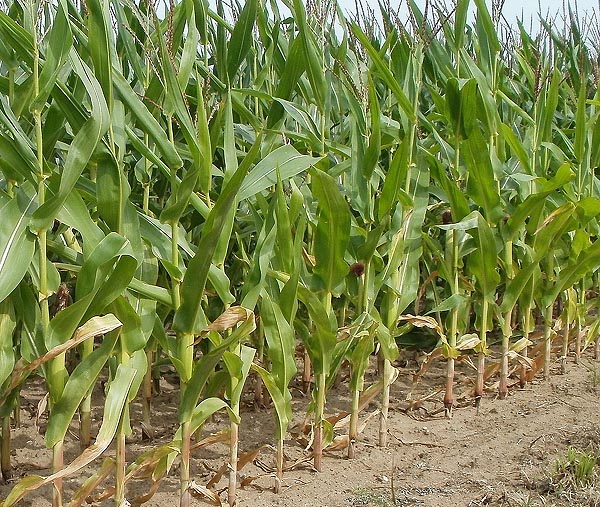
Corn needs to be planted in large blocks. The spiky bits at the top
produce the pollen that is then blown by the wind to be caught by the
corn silk on the female flowers lower on the plant. Without dense planting
there is no pollination.
3. Asparagus. While this is a wonderful vegetable it takes time and patience. You need to have an asparagus bed for three years before you can begin to harvest crop from it. While you may want to start one now you wont get the rewards for several years.
4. Onions. If you can get onion sets then it might be worth growing, but growing from seed is time consuming to get really large onions you need sets which are tiny onions (those grown from seed the first year) to turn into larger onions this year. Growing from seeds will give you onion sets in the first year to grow to large onions the following year.
HERBS TO GROW.
While it might seem unimportant to grow herbs in your garden they serve
several purposes.
- Many herbs will help to guard your plants from pests and diseases by
repelling them so your vegetables are healthier and stronger.
- They attract pollinators to your garden. These are essential to pollinate
your plants so you can get the food you want. Without the bees and other
pollinators there will be no food.
- They can add flavour to your cooking.
- Many are good and keeping you and your family healthy.
WHICH HERBS SHOULD I GROW?
1. Basil. Its very easy to grow and will crop throughout the year. We prefer to recommend Holy Basil. It has a very similar smell and taste to regular Sweet Basil but its also extremely good for you. It will grow prolifically and can be harvested all season long. Its also a magnate for pollinators to your garden. If you want something more exotic there is always Lime Basil or Cinnamon Basil which are both delicious and interesting to grow.
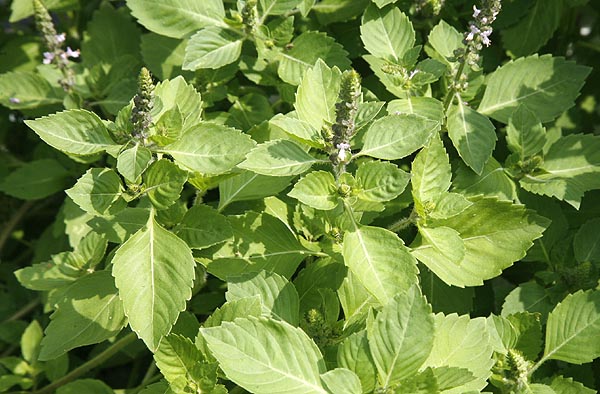
Holy basil. Smells and tastes wonderful. Cut be cut almost to the ground
several times during the year and it will regrow. A few plants will be
sufficient for a family of four.
2. Good King Henry. This is a very good herb for health but its also a spinach like plant that is a perennial so you only have to plant it once and you get leaves every year. It will also grow in semi shade so it can be placed at the back of the garden and still thrive. Starts producing leaves in mid spring before any other plant is available so good fresh leaves early.
3. Herbs to help with the Covid-19. While there is no cure for this virus you can use herbs to help boost your immune system so its in better shape to fight it off if you contract it. That means you could get milder symptoms and recover quicker. There is no guarantee with this as it will depend on a lot of other factors like you age, weight, medical problems and history keeping your immune system as healthy as possible can only be a benefit. If you are interested in herbs to help with this read Grow your own medicine. Beat back the Coronavirus in your own back yard.
4. Calendula. This is a old fashioned kind of marigold that is also very good for you for many reasons. You eat the flowers or make a tea from them. They contain compounds that are really good for the eyes and help prevent macular degeneration. They also have good antioxidants and is also used to treat flu and viruses. Not only that the beautiful cheerful yellow flowers look great in the garden.
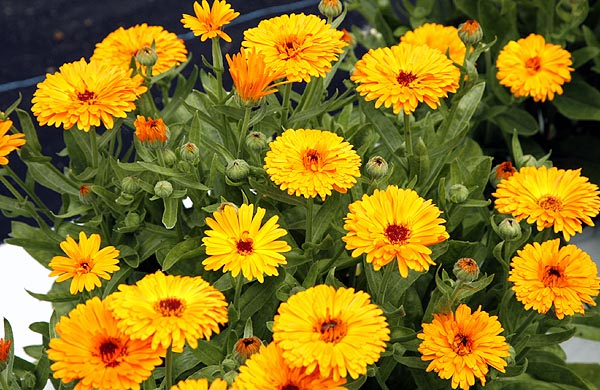
Calendula is such a cheerful flower. Flowers can be eaten the golden
coloring helps prevent macular degeneration. Plants are also good topically
for scrapes and wounds. They also repel mosquitoes.
5. Fennel. Great for adding flavor to foods, the leaves can be eaten in salads or added to drinks (great in vodka). Fennel also keeps other insects from your garden, but it grows tall so be mindful where you place it. It's also a perennial so consider that it will be in your garden for a while when you decide where to put it.
6. Lemon Balm. This lovely perennial has a wonderful lemon scent which will help keep mosquitoes from your garden, very desirable when you are weeding. Its leaves make a wonderful tea or added to cool summer drinks they have a nice calming effect just what is needed at the moment. Its low growing so don't put it at the back of the bed.
7. Parsley. Very easy to grow and produces loads of leaves that can be continually harvested throughout the season will keep producing until frost. Great for seasoning and a good medicinal herb too. There are two kinds Triple Curled and Italian. They both taste about the same its all about which you like the look of best. Personally I think Tripled Curled just looks more exotic and it smells great.

The leaves of tripled curled parsley look so exotic. They smell and
taste strongly and are useful medicinally as well as flavoring foods.
8. California Poppy. A lovely plant with blue green foliage and lovely bright golden flowers. The whole plant is medicinal its easy to grow and helps with calming stress, helps you sleep, is a mild pain killer and its very easy to grow. Bees love it too.
9. Okay there are a ton of other herbs I would like to recommend but there won't be room in your garden for all of them. If you are interested check thorough our catalog and pick out some others you like. Our pinterest page shows photos of herbs for different conditions and for different uses too.
What you grow is up to you if one crop fails then try another gardening is an ever changing experiment. Go out and experiment and explore.
OTHER NEW GARDEN INFORMATION
How to start seeds to get the best possible plants.
Tools You Need To Make A Simple Garden.
How to Choose a Potting or Seeding Mix.
What Plants should I grow in my new Garden?.
Designing your garden for summer heat
Potting on your seedlings get get the best possible plants.
| Janice Hazeldine PhD is the owner and head grower of Floral Encounters an organic Medicinal Herb farm that is also a designated sanctuary for pollinators. |





